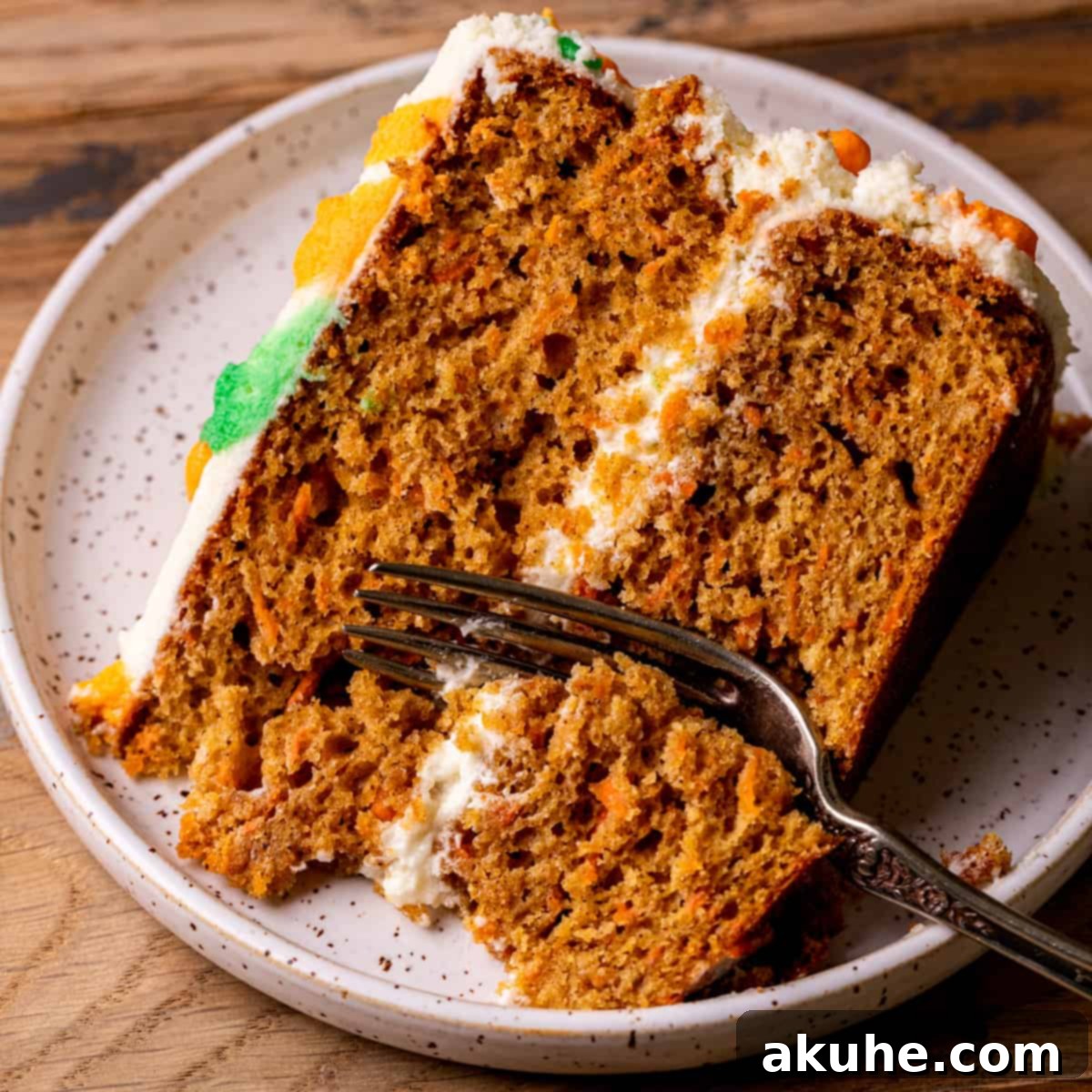Welcome to the ultimate guide for creating the Best Carrot Cake Recipe you’ll ever encounter. This isn’t just any carrot cake; it’s a two-layer masterpiece crowned with luscious, tangy cream cheese frosting. Renowned for its unparalleled moisture and a symphony of warm spices, this cake transcends ordinary desserts to become a truly unforgettable experience. Perfectly suited for festive gatherings like Easter or simply elevating a weekend treat, this recipe promises to deliver a show-stopping dessert that will earn you endless compliments. Prepare to bake the most flavorful, tender, and irresistibly moist carrot cake, designed to impress even the most discerning palates.
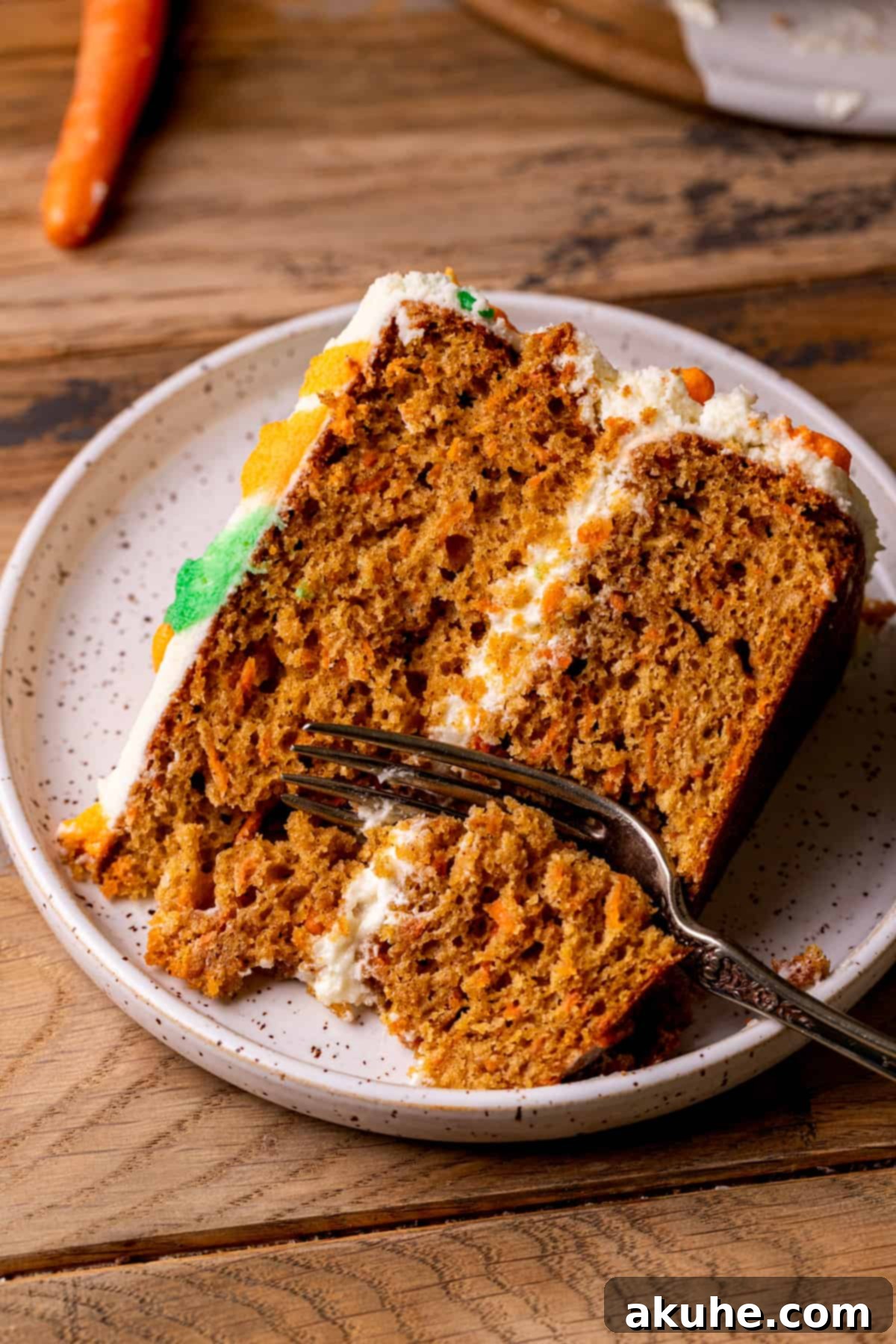
Crafting the perfect carrot cake requires a delicate balance of ingredients and a meticulous process. After extensive testing of numerous recipes, we’ve perfected this version to achieve an ideal blend of robust, aromatic spices, incredibly moist cake layers, and a velvety smooth cream cheese frosting that provides the perfect tangy contrast. This Moist Carrot Cake is a consistent crowd-pleaser, receiving rave reviews every single time it’s served. We’ve also included invaluable tips throughout this guide to ensure your baking journey is a success, guaranteeing you achieve the best possible results. Whether you’re a seasoned baker or new to the kitchen, our detailed instructions will help you create a truly exceptional dessert.
For those eager to explore more delightful spring cake creations, be sure to try our Nutella Cake, a rich and decadent choice; our Moist Chocolate Cake, a classic favorite; and our playful Cookie Dough Cake, perfect for celebrations.
Why This Perfect Carrot Cake Recipe Stands Out
What makes this specific carrot cake recipe superior? It’s a combination of thoughtfully selected ingredients and precise techniques that result in a truly remarkable dessert. Here are the key elements that set our recipe apart:
- Unrivaled Moist Cake Layers: Our recipe focuses on achieving an incredibly tender and moist crumb that practically melts in your mouth. The secret lies in a careful balance of wet ingredients, including both oil and buttermilk, ensuring the cake remains luscious for days. Every bite of this Moist Carrot Cake is a joy, offering a luxurious texture that’s difficult to resist.
- Harmonious and Rich Flavor Profile: We’ve meticulously tested and perfected the blend of warm spices. This cake features a balanced combination of cinnamon, nutmeg, and ginger, creating a depth of flavor that is both comforting and exhilarating. The spices beautifully complement the natural sweetness of the carrots, resulting in a complex and utterly delicious taste experience that is neither overwhelming nor bland.
- The Essential Cream Cheese Frosting: A carrot cake simply isn’t complete without its traditional cream cheese frosting. Our recipe delivers a frosting that is not only creamy and smooth but also perfectly tangy. This delightful tang cuts through the richness of the cake, creating a balanced and addictive flavor combination. It’s the ideal crowning glory, enhancing every aspect of this perfect dessert.
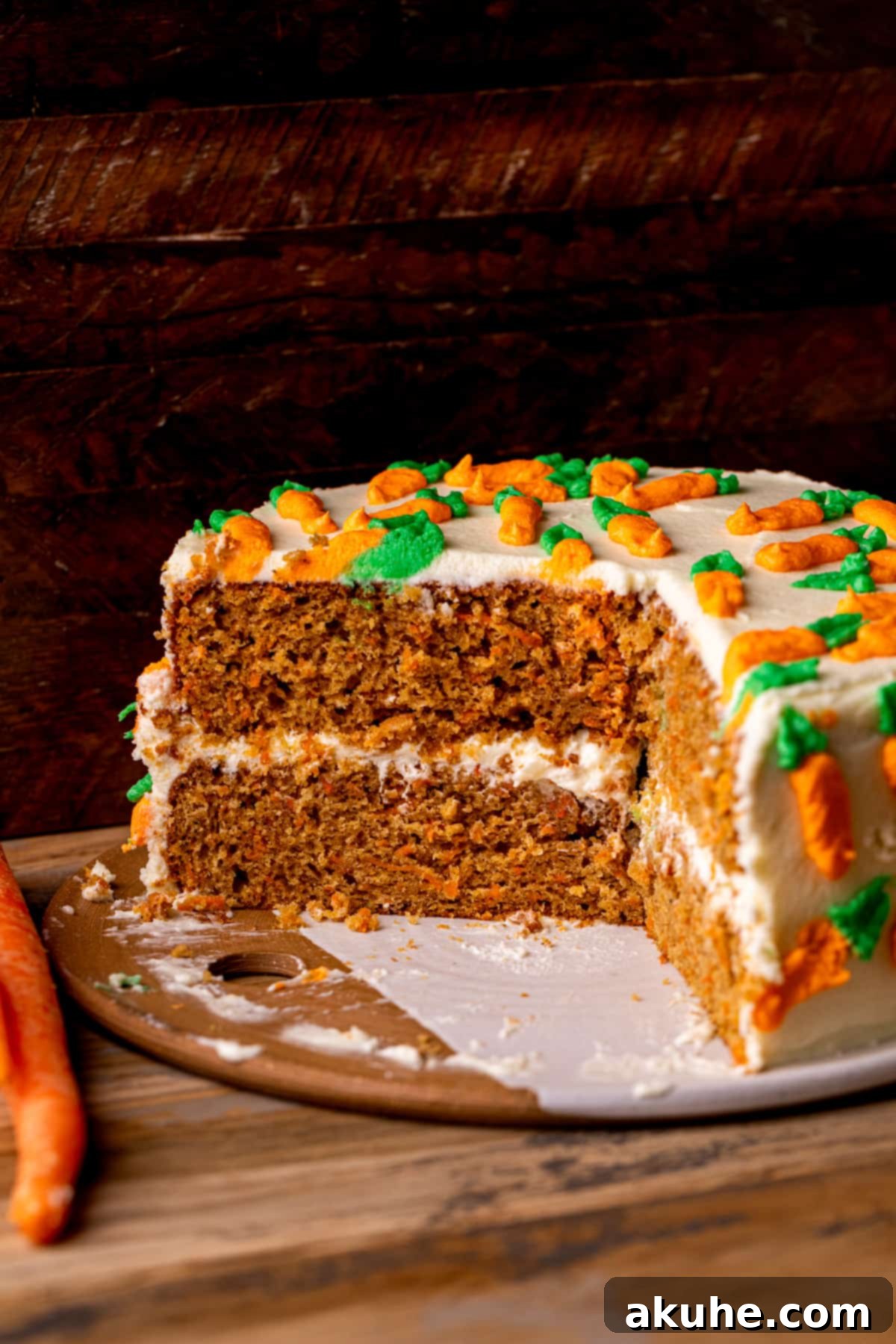
Key Ingredient Notes for Your Homemade Carrot Cake
Understanding the role of each ingredient and preparing them correctly is crucial for achieving the perfect Homemade Carrot Cake. Here are detailed notes on the ingredients you’ll need. For a comprehensive list of quantities, please refer to the recipe card below.
- Unsalted Butter: Always opt for unsalted butter to control the overall saltiness of your frosting. It’s imperative that the butter is at room temperature before you begin baking, typically requiring about 2 hours outside the refrigerator. Room temperature butter creams better with cream cheese, resulting in a smoother, lump-free frosting.
- Oil: The use of oil (canola, vegetable, or a light olive oil) is key to the cake’s exceptional moisture. Unlike butter, oil remains liquid at room temperature, contributing to a consistently moist and tender crumb that stays fresh longer.
- Eggs: Large eggs are specified, and like butter, they should be at room temperature. This allows them to emulsify more effectively with other ingredients, creating a more uniform and stable batter, which in turn leads to a lighter and fluffier cake texture.
- Buttermilk: Full-fat or reduced-fat buttermilk both work beautifully in this recipe. Buttermilk adds a subtle tang and contributes significantly to the cake’s tender crumb. Its acidity reacts with baking soda, promoting a light and airy texture. Ensure it’s at room temperature for optimal mixing.
- Sour Cream: Another essential ingredient for moisture and a slight tang, sour cream also helps create a wonderfully rich and tender cake. Bringing it to room temperature before mixing helps it incorporate smoothly into the batter without clumping.
- Cream Cheese: For the frosting, use full-fat block cream cheese, not spreadable varieties, as they contain too much water and can make your frosting runny. Like butter, it must be at room temperature. This ensures it beats into a smooth, creamy consistency without lumps.
- Powdered Sugar: Also known as confectioners’ sugar, this ingredient is vital for smooth frosting. Always sift your powdered sugar to eliminate any lumps. Un-sifted powdered sugar can lead to a gritty, unpleasant frosting texture.
- Carrots: Freshly grated carrots are non-negotiable for the Best Carrot Cake Recipe. Pre-shredded carrots from the grocery store are often thicker, drier, and can result in a tougher texture in the finished cake. Grate your carrots using the finest side of your box grater for optimal integration and moisture retention in the batter. Leaving grated carrots out for too long can dry them out, so grate them just before use.
- Food Dye (Optional): If you plan to decorate with piped carrots, invest in a high-quality gel food dye. Cheaper liquid dyes may require a larger amount to achieve vibrant colors, potentially altering the taste and consistency of your frosting.
Smart Ingredient Substitutions and Adaptations
While we highly recommend sticking to the original recipe for the Best Carrot Cake experience, here are some thoughtful substitutions for dietary needs or ingredient availability:
- Dairy-Free Option: This recipe can be adapted to be dairy-free by using your favorite plant-based alternatives. Replace unsalted butter with a high-quality dairy-free butter stick (not margarine). Substitute buttermilk with a dairy-free milk alternative (like almond or soy milk) mixed with a tablespoon of lemon juice or apple cider vinegar (see buttermilk substitute below). For cream cheese, use a dairy-free cream cheese block, ensuring it’s at room temperature.
- Gluten-Free Exploration: While this particular recipe has not been personally tested with gluten-free flour, many bakers find success by substituting all-purpose flour with a 1:1 gluten-free baking flour blend that contains xanthan gum. Ensure your baking powder and baking soda are also gluten-free. If you experiment with a gluten-free version, please share your results!
- Buttermilk Substitute: If you don’t have buttermilk on hand, you can easily make your own. Combine 1 cup of regular milk (dairy or non-dairy) with 1 tablespoon of white vinegar or lemon juice. Stir gently and let it sit for 10 minutes. The milk will curdle slightly, producing a perfect buttermilk substitute.
Step-By-Step Instructions: Crafting Your Carrot Cake Layers
Follow these detailed steps to create the perfectly moist and flavorful cake layers that form the foundation of our Best Carrot Cake Recipe:
STEP 1: Prepare Your Baking Environment. Begin by preheating your oven to 350°F (175°C). While the oven heats, thoroughly spray two eight-inch round cake pans with a high-quality baking nonstick spray. To ensure easy release and prevent sticking, line the bottoms of the pans with pre-cut parchment paper circles. For extra security, spray the parchment paper circles again with baking spray. This double layer of protection is crucial for pristine cake layers.
STEP 2: Prepare the Carrots. Using the finest side of your box grater, carefully grate fresh, peeled carrots until you have 2 1/2 cups, firmly packed. Finely grated carrots blend seamlessly into the batter, distribute moisture evenly, and create a tender texture without noticeable chunks. Avoid using coarse shreds or pre-packaged grated carrots, as they can result in a dry or unevenly textured cake.
STEP 3: Combine Dry Ingredients. In a large mixing bowl, whisk together the all-purpose flour, cornstarch, baking powder, baking soda, salt, ground cinnamon, ground nutmeg, and ground ginger. Ensure these dry ingredients are thoroughly combined to guarantee even leavening and spice distribution throughout the cake. Set this bowl aside.
STEP 4: Mix Wet Ingredients. In a separate, medium-sized bowl, combine the oil, brown sugar (light or dark, packed), granulated white sugar, room-temperature sour cream, room-temperature buttermilk, the freshly grated carrots, room-temperature large eggs, and pure vanilla extract. Whisk these ingredients together until they are fully combined and the mixture is smooth. This ensures all the moistening and flavoring components are well integrated.
STEP 5: Gently Combine Wet and Dry. Pour the wet ingredient mixture directly into the bowl with the dry ingredients. Using a spatula or spoon, gently fold the wet into the dry until the batter is just smooth and no pockets of dry flour remain. Be careful not to overmix, as overmixing can develop gluten, leading to a tough, dense cake. Mix until just combined.
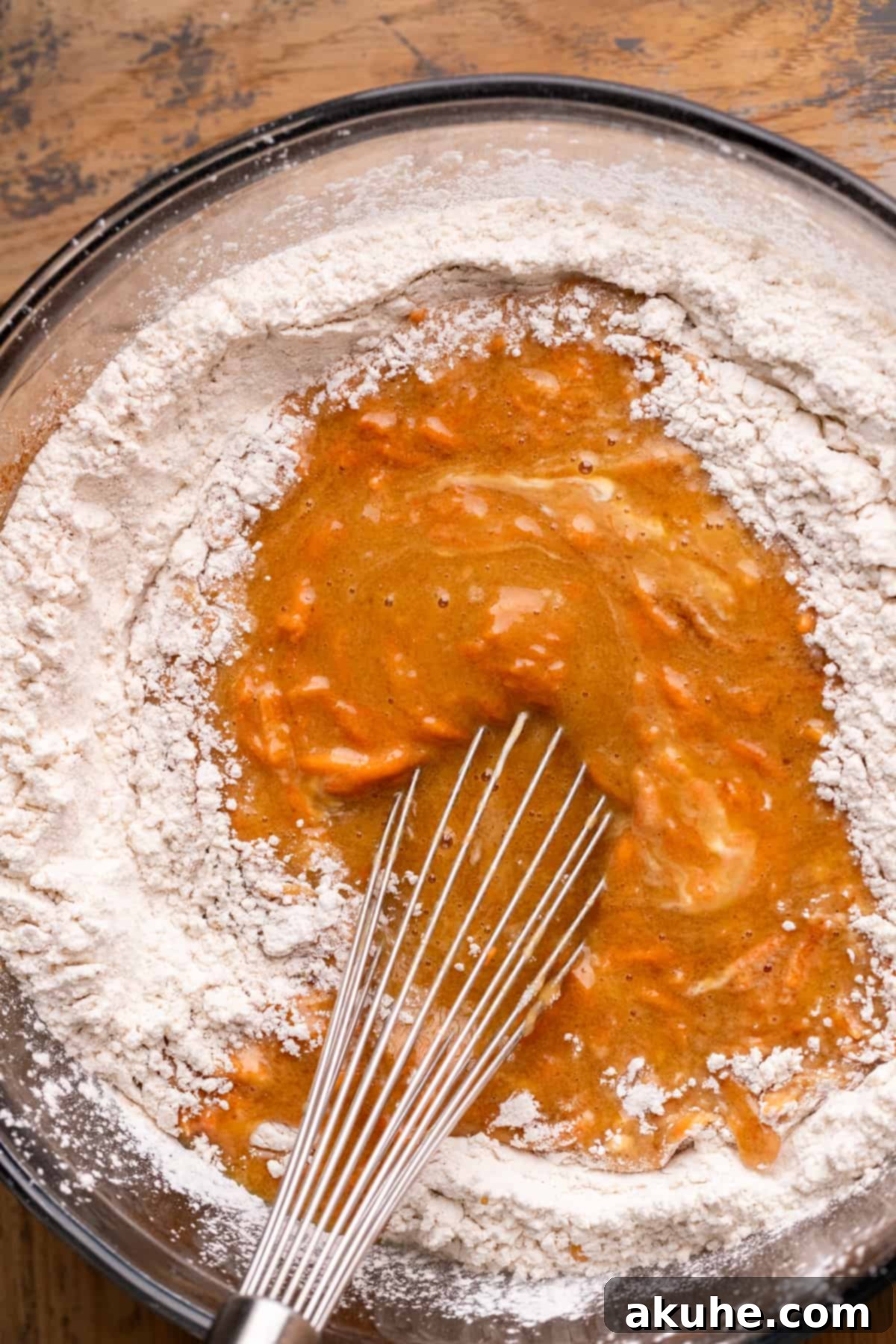
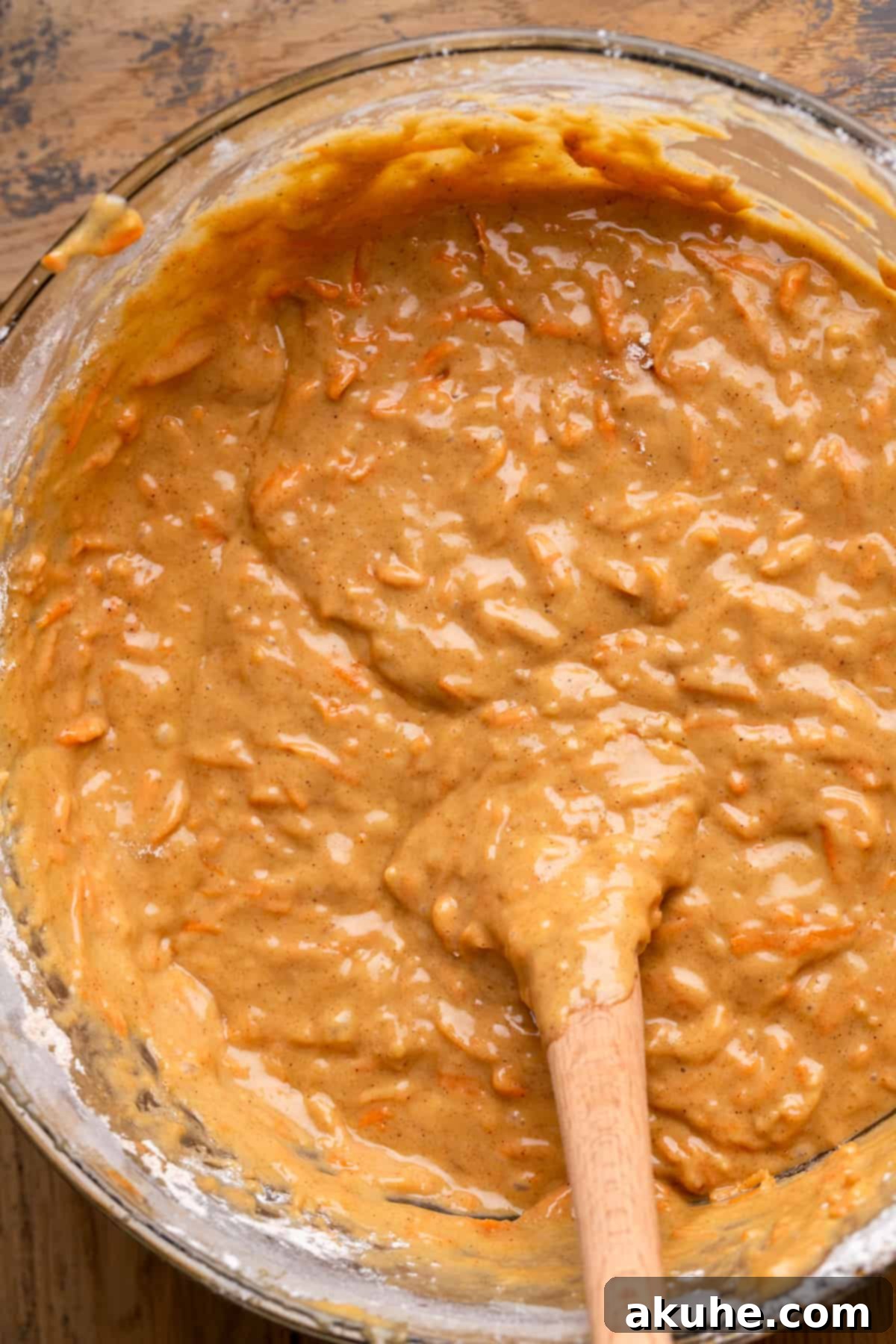
STEP 6: Bake the Cake Layers. Divide the carrot cake batter evenly between the two prepared eight-inch cake pans. Place the pans into the preheated oven and bake for approximately 22-25 minutes. The cakes are fully baked when a toothpick inserted into the center of each cake comes out clean or with only a few moist crumbs attached. Avoid opening the oven door too frequently during baking to prevent the cakes from sinking.
STEP 7: Cool Properly. Once baked, remove the cakes from the oven and allow them to rest in their hot pans for 10 minutes. This crucial step allows the cakes to firm up slightly, preventing them from breaking when transferred. After 10 minutes, carefully invert the cakes onto a wire rack to cool completely. Ensure the cakes are absolutely cool to the touch before attempting to frost them; frosting a warm cake will lead to a melty, messy disaster.
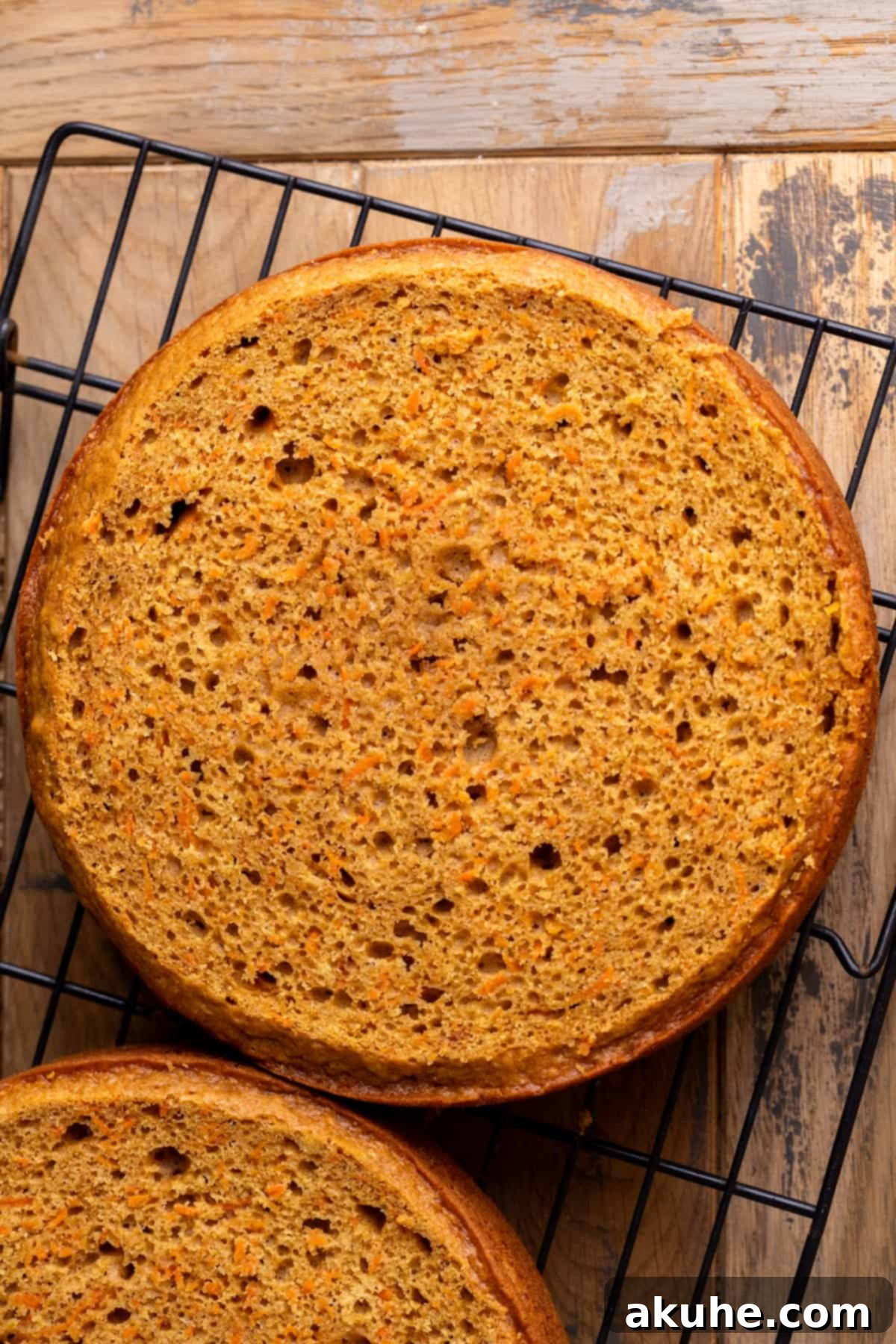
Step-By-Step Instructions: Crafting the Perfect Cream Cheese Frosting
This rich and tangy cream cheese frosting is the ideal complement to our Moist Carrot Cake. Follow these steps for a perfectly smooth and pipeable frosting:
STEP 1: Sift Powdered Sugar. In a medium bowl, carefully sift the powdered sugar. This crucial step removes any lumps, ensuring your frosting is wonderfully smooth and free of gritty texture. Set the sifted sugar aside.
STEP 2: Cream Butter and Cream Cheese. In the bowl of a stand mixer fitted with the paddle attachment (or using a hand mixer), beat the room-temperature unsalted butter and room-temperature cream cheese together on high speed for 2 minutes. Continue beating until the mixture is light, fluffy, and perfectly creamy. If you notice any chunks of butter or cream cheese sticking to the sides of the bowl, stop the mixer, scrape down the sides, and beat again until completely smooth.
STEP 3: Gradually Add Powdered Sugar. With the mixer on low speed, gradually add half of the sifted powdered sugar to the butter and cream cheese mixture. Mix until it is just combined and no dry streaks remain. Then, add the remaining half of the powdered sugar and continue mixing on low speed until fully incorporated. Mixing on low speed initially prevents a cloud of powdered sugar from escaping your bowl.
STEP 4: Incorporate Vanilla. Add the pure vanilla extract to the frosting. Increase the mixer speed to high and beat for another 1-2 minutes until the frosting is incredibly creamy, light, and airy. Be careful not to overbeat, as this can sometimes incorporate too much air, making the frosting unstable.
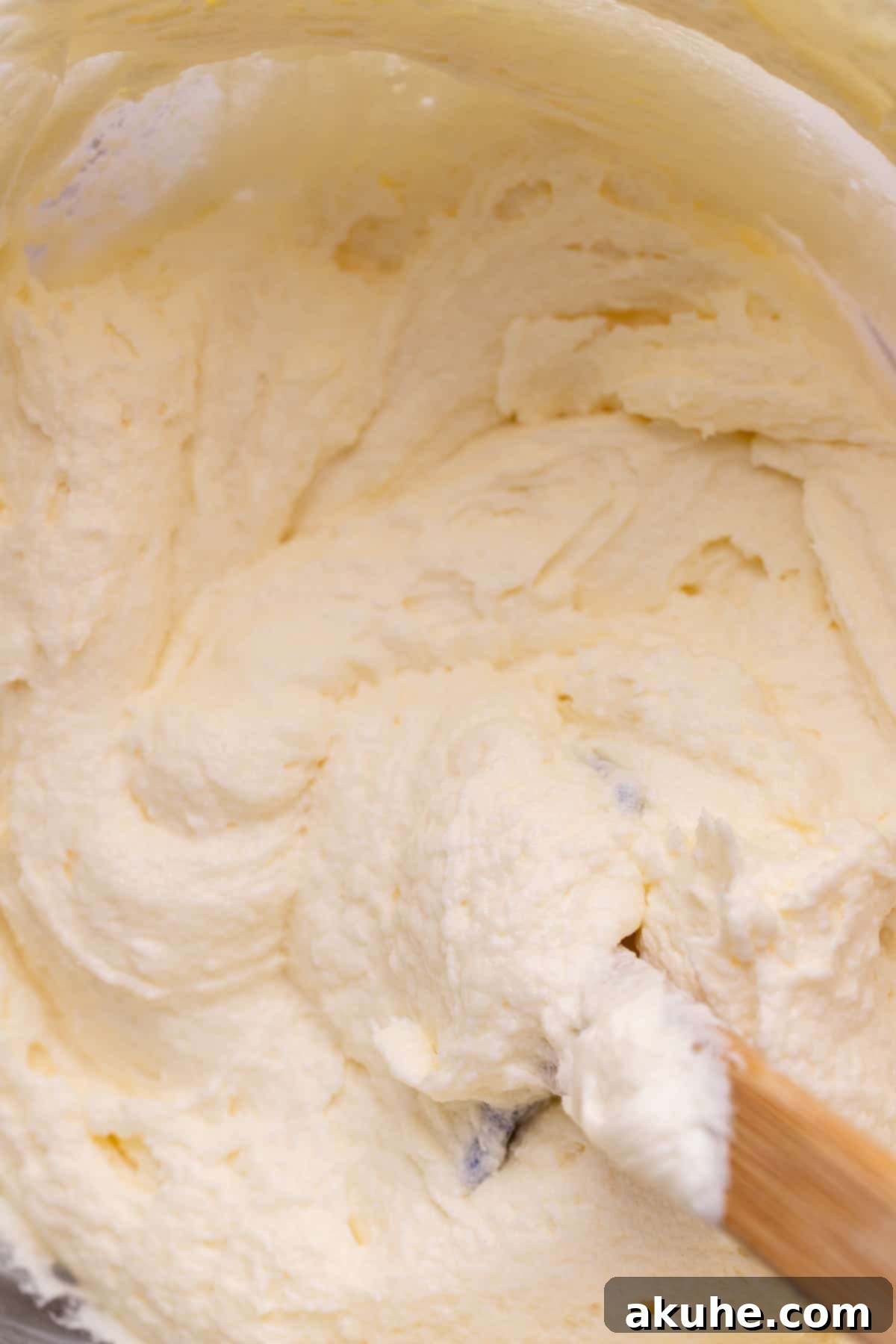
STEP 5: Prepare for Decorations (Optional). If you wish to pipe decorative carrots onto your finished cake, separate a small amount of frosting. Place 2 tablespoons of frosting into one small bowl and 1/4 cup into another. Dye the 2-tablespoon portion green for the carrot tops and the 1/4-cup portion orange for the carrot bodies. Cover these colored frostings tightly until ready to use.
Assembling and Decorating Your Masterpiece
Bringing all the components together is where your Perfect Carrot Cake truly comes to life. Follow these steps for a beautifully assembled and decorated cake:
STEP 1: Position the First Layer. Place the first completely cooled cake layer onto your serving platter or cake stand. Spread approximately 1 cup of the prepared cream cheese frosting evenly over the top of this layer, extending it almost to the edges. An offset spatula is an excellent tool for achieving an even spread.
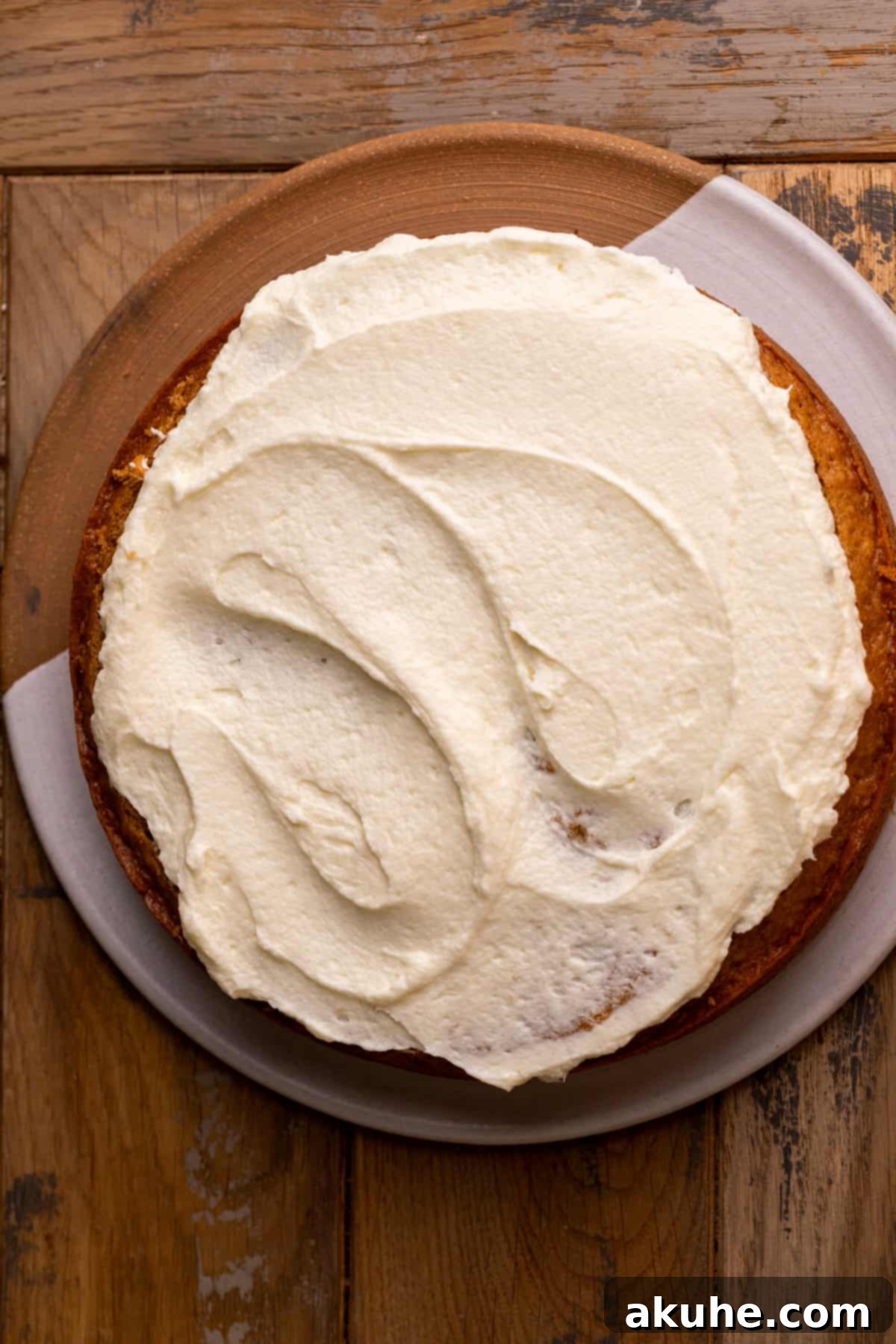
STEP 2: Add the Second Layer. Carefully place the second cooled cake layer on top of the frosted first layer. For a more stable and level cake, it’s often best to place this second layer upside down. This way, the flat bottom of the cake becomes the flat top of your assembled cake, providing a smooth surface for frosting.
STEP 3: Apply the Crumb Coat. Using a small amount of frosting (about 1/2 to 3/4 cup), apply a very thin, light layer over the entire cake – top and sides. This is known as a “crumb coat.” The purpose of the crumb coat is to trap any loose crumbs, preventing them from mixing into your final layer of frosting. Once applied, place the cake in the freezer for about 15 minutes to allow this thin layer to set firmly.
STEP 4: The Final Frosting Layer. Once the crumb coat is firm, remove the cake from the freezer. Apply the remaining cream cheese frosting generously and evenly over the top and sides of the cake. Use an offset spatula or a cake scraper to achieve a smooth, professional finish. Take your time to create a surface that is as smooth or as textured as you desire.
STEP 5: Pipe Decorative Carrots (Optional). If you chose to color frosting in Step 5 of the frosting instructions, now is the time to add your decorative touches. Fit a piping bag with a Wilton 6 tip for the orange carrot bodies and another piping bag with a Wilton 67 tip for the green leaves. Pipe small, charming carrots randomly or in a pattern all over the top and sides of the cake, adding a festive touch, especially perfect for an Easter Carrot Cake.
Expert Baking Tips for Your Best Carrot Cake
Achieving a truly outstanding carrot cake involves more than just following steps; it’s about understanding the nuances of baking. Here are some invaluable expert tips to elevate your Homemade Carrot Cake to perfection:
- Accurate Flour Measurement is Paramount: One of the most common baking errors is incorrect flour measurement, which can drastically affect the final texture of your cake. Always use the “spoon and level” method: gently spoon flour into your measuring cup until it overflows, then level off the excess with the back of a knife. Never scoop flour directly from the bag, as this compacts it, leading to an excess of flour and consequently, a dry, dense cake. For ultimate precision, consider using a kitchen scale to measure flour by weight (grams).
- Thorough Pan Preparation for Effortless Release: To ensure your beautiful cake layers release from the pans without sticking or tearing, meticulous pan preparation is key. Start by generously spraying the inside of your cake pans with a nonstick baking spray that contains flour. Next, line the bottoms of the pans with parchment paper circles – either pre-cut or custom-cut to fit. Then, spray the parchment paper again. This double layer of nonstick coverage ensures that no part of your cake sticks, guaranteeing perfectly formed layers every time. Be thorough, as any missed spot can lead to tearing.
- Embrace Room Temperature Ingredients: This tip is repeatedly emphasized for a reason. Ingredients like butter, cream cheese, eggs, buttermilk, and sour cream at room temperature are crucial for a smooth, cohesive batter and frosting. Room temperature ingredients emulsify much better, meaning they mix together evenly without separating. This results in a lighter, more uniform cake batter and a truly creamy, lump-free frosting. Plan ahead by pulling these ingredients out of the fridge 1-2 hours before you start baking.
- Avoid the Temptation to Overmix: Once you combine your wet and dry ingredients, mix them only until they are just combined and no dry streaks of flour are visible. Overmixing develops the gluten in the flour, which can lead to a tough, chewy, and less tender cake. A light hand and patience will ensure a soft, delicate crumb.
- Cool Cakes Completely Before Frosting: Resist the urge to frost warm cakes! Warmth will melt your cream cheese frosting, causing it to slide off the cake and create a messy, unappealing finish. Ensure your cake layers are completely cool to the touch – preferably chilled slightly – before you even think about applying that glorious frosting.
- High-Altitude Baking Adjustments: For bakers living at higher altitudes (typically above 3,500 feet), adjustments are often necessary. Air pressure is lower, causing cakes to rise faster and dry out more quickly. To counteract this, add an extra 2-3 tablespoons of all-purpose flour to the cake batter. You might also need to slightly decrease the amount of baking powder/soda and increase the liquid slightly. Monitor baking times closely, as they can be shorter at higher altitudes.
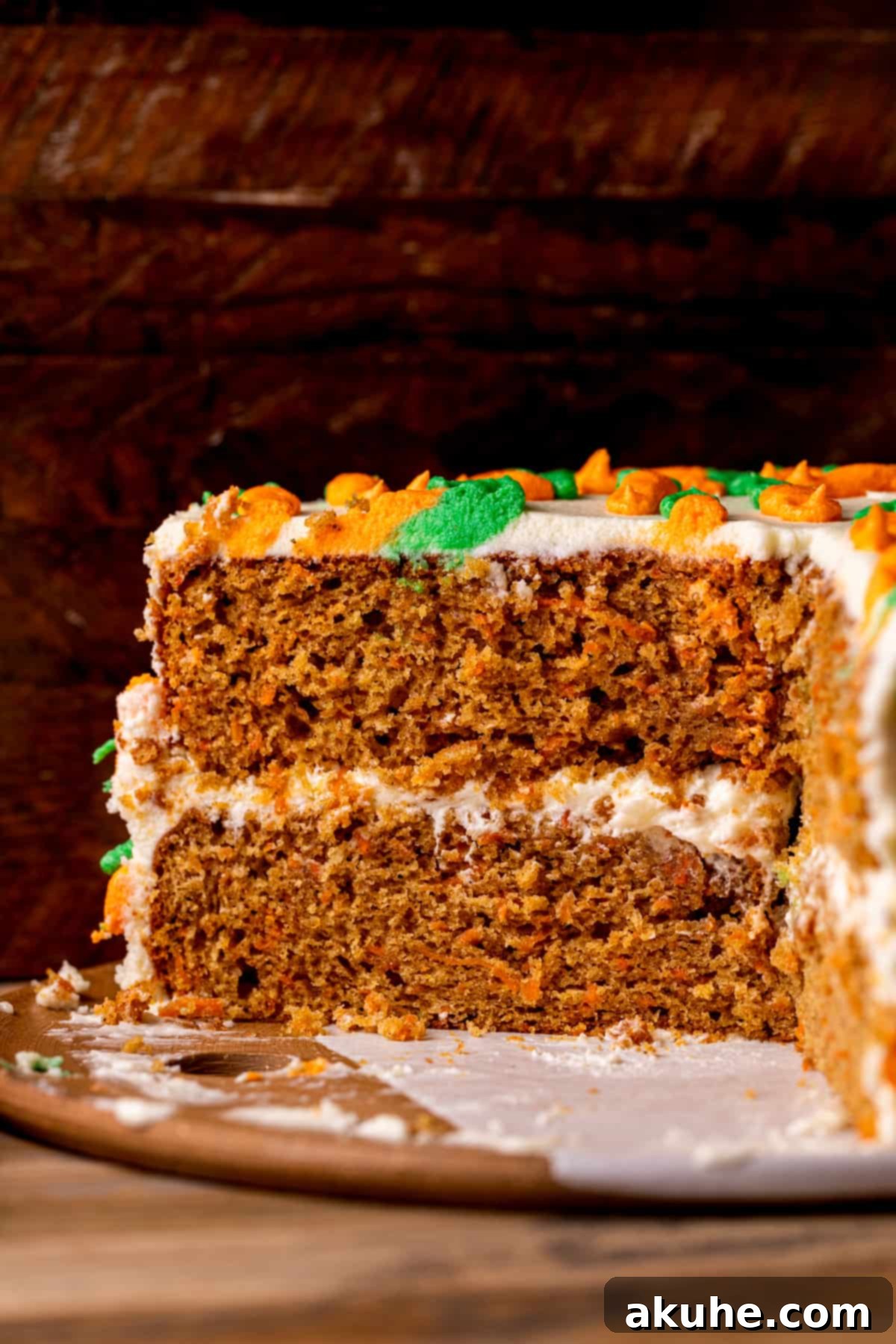
Frequently Asked Questions (FAQ) About Carrot Cake
Absolutely! Preparing cake layers in advance is a fantastic time-saver, especially when planning for special occasions like Easter. Once your cake layers have cooled completely on a wire rack, wrap each layer tightly and individually in plastic wrap, then an additional layer of aluminum foil. You can then freeze them for up to 30 days. When you’re ready to decorate, simply pull them out of the freezer about 1 hour before you plan to frost, allowing them to thaw at room temperature. You can even frost them while slightly chilled, which makes handling easier.
Yes, you can certainly adjust the pan size, keeping in mind that it will affect the cake’s thickness and potentially the baking time. If you use 9-inch cake pans, your cake layers will be thinner, so you’ll need to reduce the baking time by a few minutes (start checking around 18-20 minutes). Conversely, if you prefer thicker, taller layers, you can use 6-inch cake pans. This will increase the baking time significantly (likely 30-40 minutes or more), so monitor closely for doneness.
Yes, this versatile carrot cake recipe is perfect for making delicious cupcakes! This recipe will yield approximately 24 standard-sized carrot cake cupcakes. Line your cupcake tins with paper liners and fill each liner about two-thirds full with batter. Bake at 350°F (175°C) for about 18-22 minutes, or until a toothpick inserted into the center comes out clean. If you only need a smaller batch, simply halve the entire recipe to make about 12 cupcakes.
For the best texture in your carrot cake, always use fresh carrots and grate them using the finest side of a box grater or a food processor with a fine grating disc. This creates delicate shreds that blend seamlessly into the batter, ensuring maximum moisture and flavor without creating a chunky or stringy texture. Avoid pre-shredded carrots from the store, as they are often thicker and drier.
Runny cream cheese frosting is a common issue, often caused by a few factors. First, ensure both your butter and cream cheese are at proper room temperature – too warm, and they’ll be too soft. Second, always use full-fat block cream cheese, not the spreadable type, which has higher water content. Overmixing can also incorporate too much air, making the frosting unstable. If it’s still too soft, try chilling it in the refrigerator for 20-30 minutes before beating again briefly, or gradually add a bit more sifted powdered sugar.
Exciting Recipe Variations to Explore
While our Best Carrot Cake Recipe is perfect as is, you can easily customize it with these delicious variations to suit your taste:
- Added Nuts: For a delightful crunch and nutty flavor, fold 1 cup of finely chopped walnuts or pecans into the cake batter just before pouring it into the pans. You can also sprinkle chopped nuts on top of the finished frosted cake for an elegant garnish.
- A Decadent Three-Layer Cake: If you desire a taller, more dramatic presentation, this recipe can be baked into a stunning three-layer cake. Simply divide the batter evenly among three 8-inch cake pans. Keep in mind that the cake layers will be thinner, so the baking time will be significantly reduced (start checking for doneness around 18-20 minutes).
- Tropical Twist: For an added burst of flavor and moisture, consider folding in 1/2 cup of well-drained crushed pineapple or shredded coconut into the batter. This adds a delightful tropical dimension to the classic carrot cake.
- Zesty Orange Infusion: Enhance the warm spices by adding the zest of one orange to the wet ingredients. The subtle citrus note complements the carrots and spices beautifully, adding a bright aroma and taste.
Special Tools for Baking Success
Having the right tools can make all the difference in your baking experience, ensuring professional results and making the process more enjoyable. Here are some of our recommended special tools for making the Best Carrot Cake Recipe:
- Quality Cake Pans: We highly recommend using sturdy 8-inch Wilton cake pans. Their even heat distribution helps ensure your cakes bake uniformly, preventing hot spots and uneven browning.
- Convenient Parchment Paper Circles: Save time and hassle with pre-cut 8-inch parchment paper circles for lining the bottom of your pans. They fit perfectly, eliminating the need to trace and cut from a roll of parchment paper, which can be tedious.
- Effective Baking Spray: A reliable nonstick baking spray with flour is your best friend for ensuring easy cake release. The added flour creates an extra barrier, guaranteeing your cakes don’t stick and come out perfectly intact every time.
- Versatile Offset Spatula: An offset spatula is an indispensable tool for bakers. Its angled blade makes it incredibly easy to spread frosting or fillings smoothly and evenly across cake layers, giving your cake a professional finish.
- Smooth-Spinning Cake Turntable: A good Ateco cast iron turntable is a game-changer for frosting cakes. Its high quality and seamless spinning motion allow you to rotate the cake effortlessly while you apply and smooth the frosting, resulting in much cleaner and more even results than frosting by hand. Avoid jerky turntables that can disrupt your flow.
- Precision Cake Scraper: To achieve impeccably smooth sides on your frosted cake, a metal cake scraper is essential. It helps you get perfectly straight and even edges, elevating the overall appearance of your finished cake.
- Generously Sized Piping Bags: These 18-inch piping bags are ideal as they hold a larger volume of frosting, reducing the need for frequent refills during decoration. This is especially helpful when working on larger cakes or intricate designs.
- Assorted Piping Tips: While this recipe specifically uses Wilton 6 for carrots and Wilton 67 for leaves, a Wilton 1M tip is a popular and versatile choice for creating beautiful swirls and borders with frosting on a wide variety of baked goods.
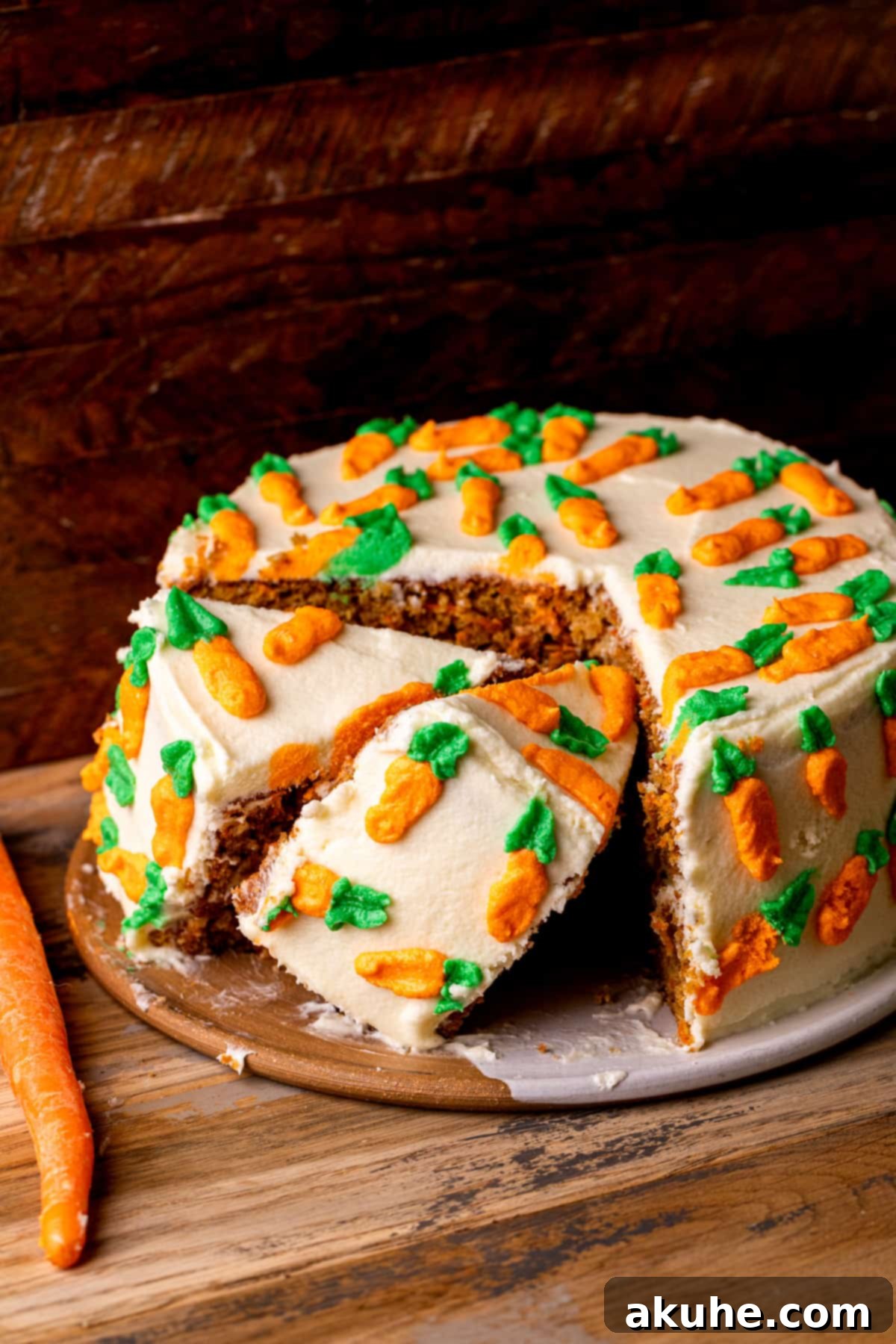
Storing and Freezing Your Delicious Carrot Cake
To keep your Homemade Carrot Cake as fresh and delicious as possible, proper storage is key. Here’s how to store and freeze it:
Storing: Since this cake contains cream cheese frosting, it must be stored in the refrigerator. Place the entire cake in an airtight cake carrier or a large container with a tight-fitting lid. This prevents it from drying out and absorbing odors from the fridge. Stored correctly, your carrot cake will remain wonderfully fresh and moist for up to 5 days.
Freezing: For longer storage, individual slices of carrot cake freeze beautifully. Once the cake is completely chilled and the frosting is firm, slice it into individual portions. Wrap each slice tightly first in plastic wrap, then in a layer of aluminum foil. Place the wrapped slices in an airtight freezer-safe container or freezer bag. This method helps prevent freezer burn and preserves the cake’s flavor and texture. You can freeze individual slices for up to 30 days. Thaw slices in the refrigerator overnight or at room temperature for a few hours before serving.
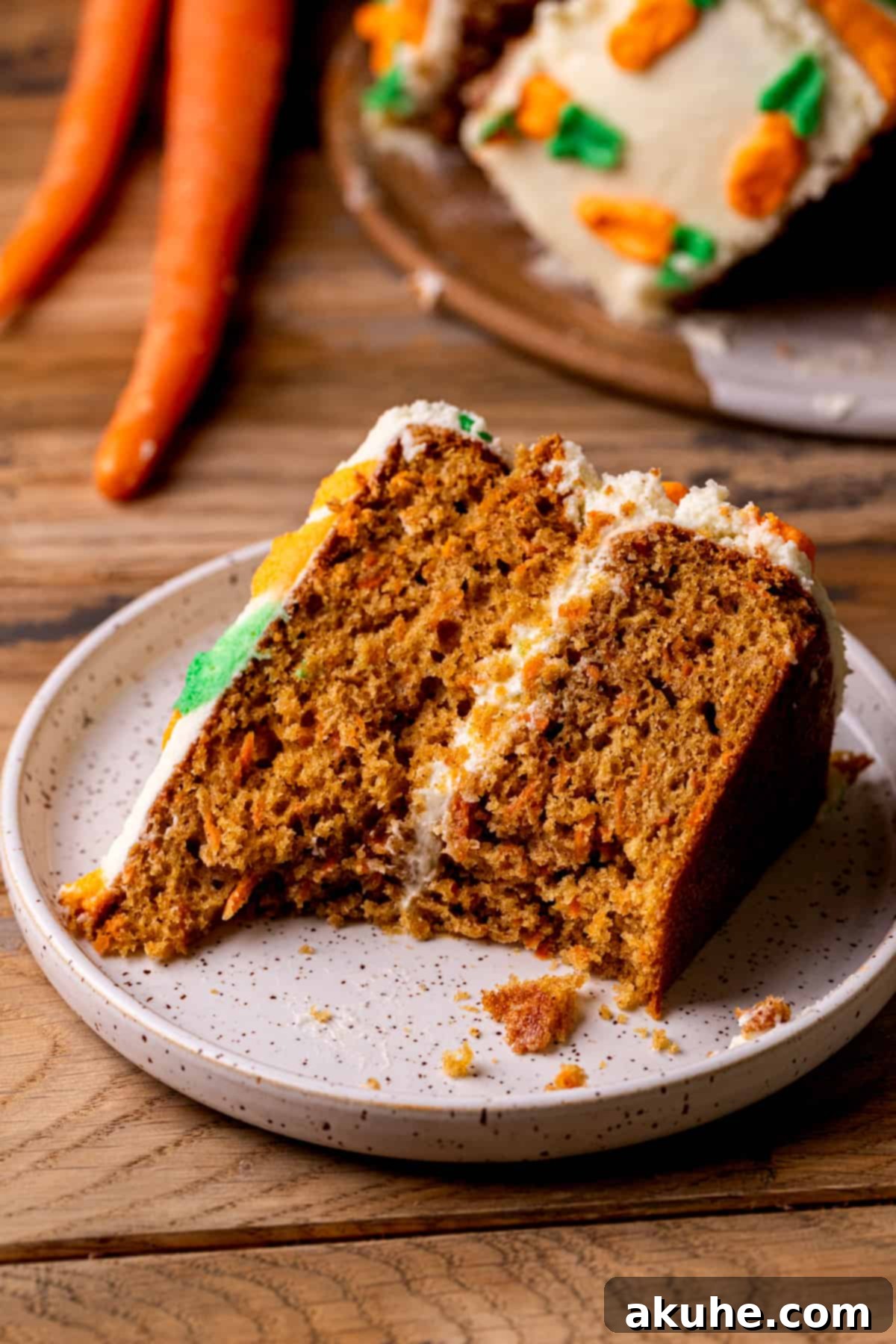
Other Delightful Easter Recipes to Try
As the spring season arrives, so do opportunities for beautiful, festive baking. Beyond our spectacular Easter Carrot Cake, here are some other recipes perfect for your holiday table or any spring celebration:
- Lemon White Chocolate Cake: A bright and elegant cake with the perfect balance of tart lemon and sweet white chocolate.
- Lemon Drizzle Cake: A moist and zesty loaf cake, soaked in a sweet lemon syrup for an irresistible finish.
- Carrot Bread: A simpler, yet equally delicious, take on the classic carrot flavor, perfect for breakfast or a snack.
- Strawberry Brownies: A vibrant and fruity twist on traditional brownies, bursting with fresh strawberry flavor.
- Strawberry Vanilla Cake: A delightful combination of sweet strawberries and classic vanilla, light and perfect for spring.
We truly hope you enjoy baking and sharing this exceptional carrot cake! If you loved this recipe, please make sure to leave a STAR REVIEW below – your feedback is invaluable. Don’t forget to tag me on Instagram @stephaniesweettreats when you share your creations. For more inspiring baking ideas and sweet treats, be sure to follow me on Pinterest. Happy baking!
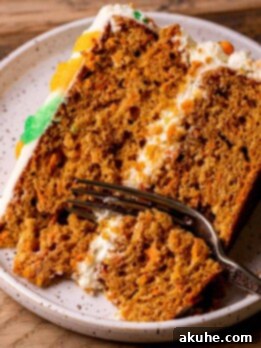
The Best Carrot Cake
Ingredients
Carrot Cake
- 3 1/4 cup All purpose flour
- 1/4 cup Cornstarch
- 2 tsp Baking powder
- 1 tsp Baking soda
- 1 tsp Salt
- 1 TBSP Ground cinnamon
- 1/4 tsp Ground nutmeg
- 1 tsp Ground ginger
- 1 cup Oil, canola or vegetable oil
- 1 cup Brown sugar, packed light or dark
- 1/2 cup White granulated sugar
- 1/2 cup Sour cream, room temperature or greek yogurt.
- 1/2 cup Buttermilk, room temperature
- 2 1/2 cups Grated carrots, 5 medium carrots.
- 4 Large eggs, room temperature
- 1 tsp Pure vanilla extract
Cream Cheese Frosting
- 2 cups Unsalted butter, room temperature
- 16 oz Cream cheese, room temperature
- 3 cups Powdered sugar, sifted
- 1 tsp Pure vanilla extract
- * Optional orange and green food dye
Instructions
Carrot Cake
- Preheat the oven to 350℉. Spray two 8-inch cake pans with baking nonstick spray. Line the bottoms with 8-inch parchment paper circles. Spray again.
- First, grate the peeled carrots. Use the smallest hole in your grater. It should be a packed 2 1/2 cups of grated carrots.
- In a large bowl, mix the flour, cornstarch, baking powder, baking soda, salt, cinnamon, nutmeg, and ginger. Set aside.
- In a separate bowl, mix the oil, brown sugar, sugar, sour cream, buttermilk, grated carrots, eggs, and vanilla. Mix until combined.
- Pour the wet ingredients on top of the dry ingredients. Mix until smooth.
- Pour the cake batter evenly into the two cake pans. Bake for 22-25 minutes. Bake until a toothpick inserted comes out clean.
- Let the cake sit in the hot pans for 10 minutes before transferring to a cooling rack. Cool completely before decorating.
Cream Cheese Frosting
- In a medium bowl, sift the powdered sugar. Set aside.
- Using a mixer, beat the butter and cream cheese on high speed for 2 minutes until creamy. If any chunks remain, scrape the bowl and beat again.
- Add in half of the powdered sugar and mix on low speed until combined. Add in the rest of the powdered sugar and mix until combined.
- Add in the vanilla and mix on high speed until creamy.
- If you want to pipe little carrots on top of the cake. Place 2 TBSP of frosting in one bowl, and 1/4 cup frosting in another bowl. Color the smaller amount green and the other bowl orange.
Assembly
- Place the first cake layer down, Spread 1 cup of frosting over the cake. Top with the second cake layer, with the bottom of the cake facing up.
- Spread a light layer of frosting around the cake. Freeze for 15 minutes. This is the crumb coat layer.
- Frost the rest of the cake.
- I used Wilton tip 6 for the carrots and Wilton tip 67 for the leaves. Pipe little carrots all over the cake.
Notes
High altitude baking- Add an extra 3 TBSP of flour.
Pull out dairy ingredients 2 hours before baking.
